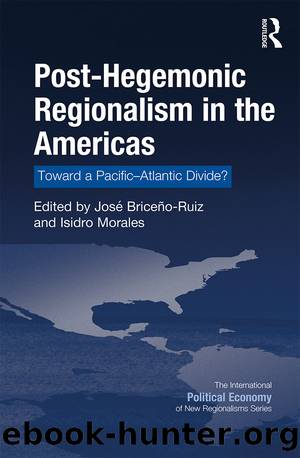An Introduction to the Philosophy of Science by Lisa Bortolotti

Author:Lisa Bortolotti [Bortolotti, Lisa]
Language: eng
Format: epub
Tags: Philosophy, General, Science, Philosophy & Social Aspects
ISBN: 9780745635385
Google: SDPhAAAAMAAJ
Goodreads: 34022440
Publisher: Wiley
Published: 2008-12-03T12:41:35+00:00
The point of departure: an appraisal of âopen regionalismâ (1990â2005)
By 1990, Latin America defined a new regional map that remained unchanged for more than 15 years. Most countries chose open-regionalism strategies â the Central American Integration System (SICA), the Andean Community of Nations (CAN), and Mercosur â adopting the goal of establishing customs unions with lower external protection for improving international competitiveness. From that line of thought came a visible convergence of the liberal views of the so-called ârevisedâ Washington Consensus (Williamson, 1997) and the neo-structuralist views of the Economic Commission for Latin America and the Caribbean (ECLAC) regarding the positive role of RTAs for encouraging dynamic competitive advantages to face the âtriadicâ postâCold War international economy (Robson, 1993; ECLAC, 1994). Incorporating some elements of the ânew-regionalismâ approach (Söderbaum & Shaw, 2003), these regional agreements also gathered the rich experience of political cooperation in the region, independently and outside of the Organization of American States (OAS), provided by peace negotiations in Central America and regional support of democratization. Mercosur, the Andean group, and SICA tried to set themselves as frameworks for âmultilevelâ regional governance to enhance their collective capacity to manage risks and interdependencies. While maintaining an essentially economic and commercial focus, these groupings acquired a higher political profile and an agenda that also encompassed political dialogue and cooperation on social and environmental issues, as well as regional security.
In a marked contrast, Mexico signed the North American Free Trade Agreement (NAFTA), a pioneering âSouthâNorthâ free trade agreement (FTA), and later other agreements such as the one signed with the European Union in 2000. Chile departed from its earlier strategy of unilateral liberalization, converging with Mexico in a hub-and-spoke strategy based on a broad array of FTAs aimed at diversifying markets, attracting investment, and becoming export platforms for the global market, particularly for the North American and the Asia-Pacific areas.
Concerning trade, open regionalism has had positive outcomes. In the 1990s, trade within the region grew faster than to other destinations. Between 1990 and 2007, total exports from Latin American and the Caribbean increased by a factor of 5.9 times, but intraregional exports increased by 7.7.5 Furthermore, in intra- and interregional markets most exports are manufactured goods with higher added value, and the participation of small and medium-sized companies is higher than in extra-regional exports that remained focused on commodities. Around 2009, manufactured goods were 80% of exports in intraregional trade, whereas commodities were 55% of exports to Europe and Asia. Despite the specialization of intraregional flows in low and medium technology goods, they are more technological and employment intensive than commodity exports, and they could also sustain emerging regional supply chains and the growing intraregional investment flows by Multilatinas (ECLAC, 2010, p. 82).
Open regionalism marked a relatively consistent period in Latin American regionalism and economic integration. However, around the mid-2000s, it started to show signs of exhaustion, and a new wave of progressive governments contested its liberal bias. CAN and Mercosur intraregional trade decreased in relative terms, even though they had adopted an integration model based on trade liberalization.
Download
This site does not store any files on its server. We only index and link to content provided by other sites. Please contact the content providers to delete copyright contents if any and email us, we'll remove relevant links or contents immediately.
Seven Skeletons by Lydia Pyne(1017)
The Ultimate Weight Loss Bible: Lose Weight and Burn Fat - Explanations and Recipes suited to you incl. Low Carb, Keto Diet, 5:2 Diet, Mediterranean diet, Dash Diet, Paleo Diet & More by Roberts Jessica Sarah(485)
Dinosaurs of Darkness by Thomas H. Rich;Patricia Vickers-Rich;(471)
Assembling the Dinosaur by Lukas Rieppel(421)
Fantastic Fossils by Donald R. Prothero(404)
Tracking the Golden Isles by Anthony J. Martin(357)
Dinosaurs—The Grand Tour, Second Edition: Everything Worth Knowing About Dinosaurs from Aardonyx to Zuniceratops by Pim Keiron(328)
Fossil Forensics: Separating Fact from Fantasy in Paleontology by Bergman Jerry & Snow Philip & Sherwin Frank & Johnson Fred & Stuart MaryAnn(327)
The Teachers by Alexandra Robbins(278)
An Alfred Russel Wallace Companion by Charles H. Smith (editor); James T. Costa (editor); David A. Collard (editor)(147)
Explaining Life Through Evolution by Prosanta Chakrabarty(140)
Fauna by Christiane Vadnais(119)
Lifeâs Grandeur: The Spread of Excellence From Plato to Darwin by Stephen Jay Gould(114)
Awakening: A Novel of Aliens and Consciousness by Stephan A. Schwartz(104)
Unfit for Purpose: When Human Evolution Collides With the Modern World by Adam Hart(98)
The Zombic Hunch: Extinction of an Intuition? by Daniel Dennett(97)
The Expanding Circle: Ethics, Evolution, and Moral Progress by Singer Peter(91)
The Future of Humanity (Second Edition) by Zhouying Jin; & Lane Jennings & Ying BAI(89)
Leonardo's Mountain of Clams and the Diet of Worms by Stephen Jay Gould(89)
